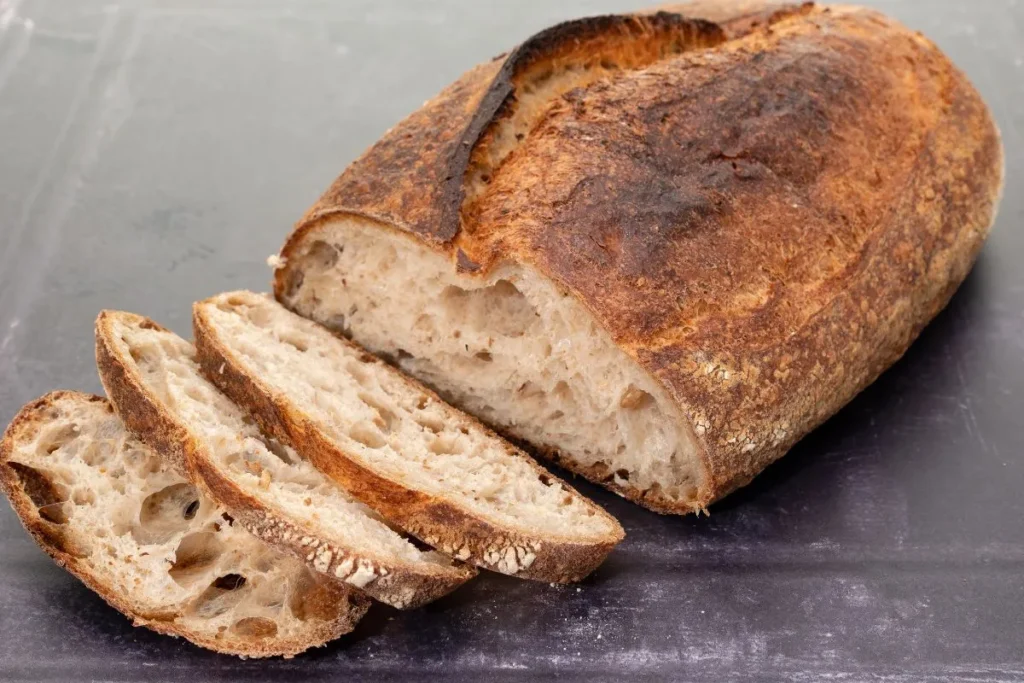Introduction
Have you ever wondered if sourdough bread is good for sandwiches? If so, you’re not alone. Many people are discovering the unique benefits of using sourdough bread for their favorite sandwiches. With its distinct tangy flavor and chewy texture, sourdough is more than just a trendy choice—it’s a delicious and nutritious option. Let’s dive into why sourdough might just be your new go-to for all things sandwich.
Table of Contents
What Makes Sourdough Bread Unique?
Sourdough bread stands out because of its natural fermentation process. Unlike regular bread, sourdough uses wild yeast and lactic acid bacteria, which give it that characteristic tangy taste. This process not only affects the flavor but also makes the bread easier to digest. Plus, it’s fascinating to think that the same method used by ancient bakers is still in play today!
Fermentation is key to sourdough’s unique qualities. Wild yeast and lactic acid bacteria work together to break down the starches and sugars in the flour. This natural process creates carbon dioxide bubbles, giving sourdough its airy, chewy texture. Moreover, the lactic acid produced during fermentation gives sourdough its distinctive tangy taste, setting it apart from other types of bread.
Why Consider Sourdough Bread for Sandwiches?
Why should you consider sourdough bread for sandwiches? Well, aside from the taste, sourdough’s texture is perfect for holding up against hefty fillings. It doesn’t get soggy as quickly as other breads, which means your sandwich stays delicious from the first bite to the last.
Sourdough’s robust crust and chewy crumb make it an excellent choice for sandwiches. The firm exterior holds up well to juicy ingredients, preventing your sandwich from turning into a soggy mess. Meanwhile, the chewy interior provides a satisfying bite that complements a variety of fillings. Whether you’re making a simple BLT or a gourmet turkey and avocado sandwich, sourdough can elevate your creation.
Benefits of Sourdough Bread for Sandwiches
Health Benefits of Sourdough Bread
Sourdough bread isn’t just tasty—it’s good for you too. Here are some of the health perks:
- Contains natural probiotics: These are good bacteria that help keep your gut healthy. The fermentation process in sourdough bread introduces probiotics, which can aid in digestion and support a healthy gut microbiome.
- Easier to digest compared to other bread: Thanks to the fermentation process, some people find sourdough easier on their stomachs. The long fermentation process breaks down gluten and other components in the flour, making it easier for your body to digest.
- Lower glycemic index: This means it won’t spike your blood sugar as much as other breads. Sourdough’s lower glycemic index helps prevent sudden spikes in blood sugar levels, which can be beneficial for those managing diabetes or insulin resistance.
Check out more about the health benefits of sourdough bread.
Taste and Texture Advantages
When it comes to sandwiches, taste and texture are everything. Here’s why sourdough excels:
- Unique tangy flavor: The fermentation gives sourdough a flavor profile that’s both tangy and slightly sweet. This unique taste enhances the overall flavor of your sandwich, making each bite more enjoyable.
- Crispy crust with a soft interior: This makes for a satisfying bite every time. The contrast between the crispy crust and the soft, chewy crumb provides a delightful texture that complements a variety of sandwich fillings.
- Holds up well with various fillings: From juicy tomatoes to hearty meats, sourdough doesn’t get soggy or fall apart. Its sturdy structure ensures that your sandwich stays intact, even with the juiciest ingredients.

Best Sandwiches to Make with Sourdough Bread
Classic Sourdough Sandwich Recipes
Here are some classic sandwiches that truly shine when made with sourdough bread:
- Sourdough BLT: The crispy bacon, fresh lettuce, and juicy tomato are perfect against the tangy backdrop of sourdough. The acidity of the bread complements the richness of the bacon and the freshness of the vegetables.
- Turkey and avocado sourdough sandwich: Creamy avocado and lean turkey make for a wholesome and delicious combination. The tangy sourdough bread adds an extra layer of flavor that ties the sandwich together.
- Grilled cheese with sourdough: The crispy crust and gooey cheese are a match made in heaven. Sourdough’s sturdy structure makes it ideal for grilling, resulting in a perfectly toasted, melty sandwich.
Discover even more with these Top 10 sourdough bread sandwich recipes.
Creative Sourdough Sandwich Ideas
Feeling adventurous? Try these creative sandwich ideas:
- Sourdough breakfast sandwich: Add some scrambled eggs, bacon, and cheese for a hearty start to your day. The tangy bread pairs well with savory breakfast ingredients, creating a satisfying morning meal.
- Vegan sourdough sandwich options: Hummus, roasted veggies, and avocado make a filling and tasty sandwich. Sourdough’s complex flavor profile complements the earthy and creamy elements of a vegan sandwich.
- Sourdough Caprese sandwich: Fresh mozzarella, ripe tomatoes, and basil drizzled with balsamic glaze on sourdough bread make a delightful and refreshing sandwich. The tangy bread enhances the flavors of the classic Caprese ingredients.
Comparing Sourdough Bread to Other Breads
Sourdough vs. Whole Wheat Bread
When comparing sourdough to whole wheat, consider these points:
- Nutritional differences: Both are nutritious, but sourdough’s fermentation process can make its nutrients more bioavailable. Whole wheat bread is rich in fiber and essential nutrients, but sourdough’s fermentation can enhance nutrient absorption.
- Flavor profiles: Sourdough has a tangy taste, while whole wheat is more earthy and nutty. The unique flavor of sourdough can add an interesting twist to traditional sandwich recipes.
- Versatility in sandwiches: Sourdough’s texture holds up better with wet ingredients. While whole wheat bread is great for many sandwiches, sourdough’s sturdiness makes it ideal for more substantial fillings.
Sourdough vs. White Bread
And what about white bread?
- Health benefits comparison: Sourdough generally has a lower glycemic index and contains beneficial bacteria. White bread is often more processed and lacks the probiotics found in sourdough.
- Texture and taste differences: White bread is soft and slightly sweet, whereas sourdough is chewy with a tangy flavor. The unique texture of sourdough can elevate a simple sandwich into something special.
- Longevity and freshness: Sourdough tends to stay fresh longer due to its acidity, which inhibits mold growth. White bread can go stale or moldy more quickly, while sourdough’s natural preservatives help it stay fresh.

Tips for Making the Best Sourdough Sandwiches
Choosing the Right Ingredients
The best sandwiches start with the best ingredients:
- Fresh and high-quality fillings: Choose fresh vegetables, quality meats, and good cheeses. Fresh ingredients make a noticeable difference in the taste and texture of your sandwich.
- Complementary flavors and textures: Think about how flavors and textures work together—crunchy, creamy, salty, and sweet. The right combination of ingredients can create a well-balanced and satisfying sandwich.
- Proper seasoning: Don’t forget to season your ingredients. A little salt and pepper can enhance the flavors of your fillings and make your sandwich even more delicious.
Learn why sourdough makes the best sandwich bread.
Preparing Sourdough Bread for Sandwiches
A few tips on prepping your bread:
- Best ways to slice sourdough: Use a sharp serrated knife for clean cuts. Slicing sourdough properly ensures that you get even pieces that hold up well in your sandwich.
- Toasting tips for extra crunch: Lightly toast to bring out the flavor and add a crunch. Toasting sourdough can enhance its natural flavors and provide a satisfying texture contrast.
- Storage tips to keep bread fresh: Store in a bread box or wrapped in a clean kitchen towel to maintain freshness. Proper storage helps keep sourdough bread from drying out or getting moldy.
Nutritional Information of Sourdough Bread
Nutritional Breakdown
Understanding the nutritional content of sourdough bread can highlight its benefits even more:
- Calories: Sourdough bread generally contains about 120-150 calories per slice, depending on the size and ingredients used.
- Carbohydrates: Each slice typically has around 20-25 grams of carbohydrates, providing a good energy source.
- Fiber: With about 1-2 grams of fiber per slice, sourdough bread contributes to your daily fiber intake, which is essential for digestive health.
- Protein: Sourdough contains about 4-6 grams of protein per slice, supporting muscle maintenance and overall body functions.
- Fat: It’s relatively low in fat, with around 0.5-1 gram per slice, making it a heart-healthy choice.
- Vitamins and Minerals: Sourdough is a good source of essential vitamins and minerals like B vitamins (especially folate), iron, magnesium, and zinc.
Health Benefits in Detail
Here’s a closer look at some of the key nutrients in sourdough bread and their benefits:
- B Vitamins: These vitamins play a crucial role in energy metabolism, helping your body convert food into energy.
- Iron: Essential for the production of hemoglobin, iron helps transport oxygen throughout your body.
- Magnesium: This mineral is important for muscle function, nerve function, and maintaining a healthy immune system.
- Zinc: Zinc supports immune function and helps with cell growth and repair.
Comparing Nutritional Value
Comparing sourdough’s nutritional value to other breads:
- Whole Wheat Bread: Higher in fiber but may not have the same level of bioavailable nutrients due to less fermentation.
- White Bread: Generally lower in fiber and essential nutrients, making sourdough a more nutritious option.
Frequently Asked Questions
Is sourdough bread healthy for sandwiches?
Absolutely! Sourdough bread contains natural probiotics, is easier to digest, and has a lower glycemic index, making it a healthy choice for sandwiches.
What fillings go well with sourdough bread?
Sourdough pairs well with a variety of fillings, including bacon, lettuce, tomato (BLT), turkey and avocado, grilled cheese, and various vegan options like hummus and roasted veggies.
Can you use sourdough bread for grilled cheese sandwiches?
Yes, sourdough is fantastic for grilled cheese sandwiches. Its crispy crust and chewy interior create a perfect texture contrast with the melted cheese.
Why is sourdough bread better than regular bread?
Sourdough has a tangy flavor, chewy texture, and contains beneficial probiotics. It also tends to have a lower glycemic index and stays fresh longer due to its acidity.
How to store sourdough bread for sandwiches?
Store sourdough bread in a bread box or wrap it in a clean kitchen towel. This helps maintain its freshness and prevents it from getting too dry or moldy.
Conclusion
To begin with, sourdough bread is undoubtedly an excellent choice for sandwiches. It offers a unique combination of taste, texture, and health benefits. Consequently, this makes it an ideal option for any sandwich. Additionally, its tangy flavor and sturdy structure hold up remarkably well against a variety of fillings. As a result, your sandwich stays delicious from start to finish. For instance, whether you’re making a classic BLT, a creative vegan option, or anything in between, sourdough can truly elevate your sandwich game. In other words, give it a try, and you will see for yourself why sourdough bread is becoming a favorite among sandwich lovers everywhere. In conclusion, the answer is a resounding yes – sourdough bread is indeed good for sandwiches.





